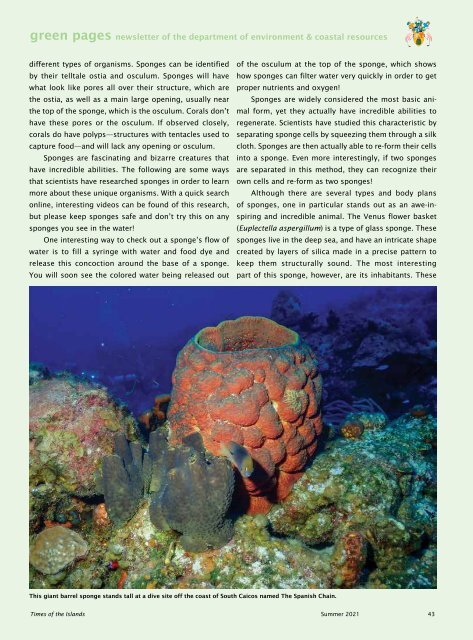Times of the Islands Summer 2021
Presents the "soul of the Turks & Caicos Islands" with in-depth features about local people, culture, history, environment, real estate, businesses, resorts, restaurants and activities.
Presents the "soul of the Turks & Caicos Islands" with in-depth features about local people, culture, history, environment, real estate, businesses, resorts, restaurants and activities.
You also want an ePaper? Increase the reach of your titles
YUMPU automatically turns print PDFs into web optimized ePapers that Google loves.
green pages newsletter <strong>of</strong> <strong>the</strong> department <strong>of</strong> environment & coastal resources<br />
different types <strong>of</strong> organisms. Sponges can be identified<br />
by <strong>the</strong>ir telltale ostia and osculum. Sponges will have<br />
what look like pores all over <strong>the</strong>ir structure, which are<br />
<strong>the</strong> ostia, as well as a main large opening, usually near<br />
<strong>the</strong> top <strong>of</strong> <strong>the</strong> sponge, which is <strong>the</strong> osculum. Corals don’t<br />
have <strong>the</strong>se pores or <strong>the</strong> osculum. If observed closely,<br />
corals do have polyps—structures with tentacles used to<br />
capture food—and will lack any opening or osculum.<br />
Sponges are fascinating and bizarre creatures that<br />
have incredible abilities. The following are some ways<br />
that scientists have researched sponges in order to learn<br />
more about <strong>the</strong>se unique organisms. With a quick search<br />
online, interesting videos can be found <strong>of</strong> this research,<br />
but please keep sponges safe and don’t try this on any<br />
sponges you see in <strong>the</strong> water!<br />
One interesting way to check out a sponge’s flow <strong>of</strong><br />
water is to fill a syringe with water and food dye and<br />
release this concoction around <strong>the</strong> base <strong>of</strong> a sponge.<br />
You will soon see <strong>the</strong> colored water being released out<br />
<strong>of</strong> <strong>the</strong> osculum at <strong>the</strong> top <strong>of</strong> <strong>the</strong> sponge, which shows<br />
how sponges can filter water very quickly in order to get<br />
proper nutrients and oxygen!<br />
Sponges are widely considered <strong>the</strong> most basic animal<br />
form, yet <strong>the</strong>y actually have incredible abilities to<br />
regenerate. Scientists have studied this characteristic by<br />
separating sponge cells by squeezing <strong>the</strong>m through a silk<br />
cloth. Sponges are <strong>the</strong>n actually able to re-form <strong>the</strong>ir cells<br />
into a sponge. Even more interestingly, if two sponges<br />
are separated in this method, <strong>the</strong>y can recognize <strong>the</strong>ir<br />
own cells and re-form as two sponges!<br />
Although <strong>the</strong>re are several types and body plans<br />
<strong>of</strong> sponges, one in particular stands out as an awe-inspiring<br />
and incredible animal. The Venus flower basket<br />
(Euplectella aspergillum) is a type <strong>of</strong> glass sponge. These<br />
sponges live in <strong>the</strong> deep sea, and have an intricate shape<br />
created by layers <strong>of</strong> silica made in a precise pattern to<br />
keep <strong>the</strong>m structurally sound. The most interesting<br />
part <strong>of</strong> this sponge, however, are its inhabitants. These<br />
This giant barrel sponge stands tall at a dive site <strong>of</strong>f <strong>the</strong> coast <strong>of</strong> South Caicos named The Spanish Chain.<br />
<strong>Times</strong> <strong>of</strong> <strong>the</strong> <strong>Islands</strong> <strong>Summer</strong> <strong>2021</strong> 43

















